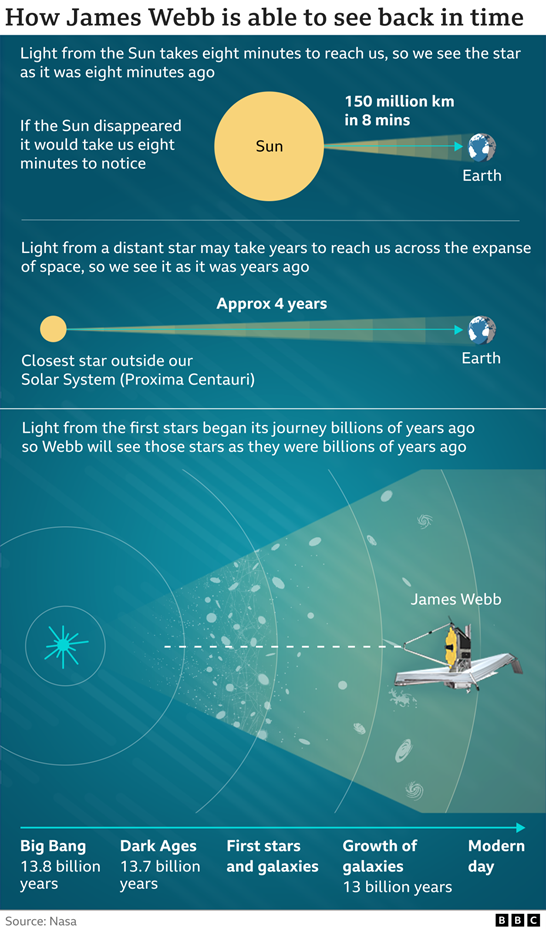

12th July 2022 (7 Topics)
Context
President Joe Biden and NASA released the clearest-ever image of our young Universe, dating to the time soon after the Big Bang.
About
- The first image from the $10 billion James Webb Space Telescope is the farthest humanity has ever seen in both time and distance, closer to the dawn of time and the edge of the universe.
- Light travels at 186,000 miles per second. And that light that you are seeing on one of those little specks has been travelling for over 13 billion years.
- Webb is considered the successor to the highly successful, but aging Hubble Space Telescope.
- Hubble has stared as far back as 13.4 billion years. It found the light wave signature of an extremely bright galaxy in 2016.
- Astronomers measure how far back they look in light-years with one light-year being 5.8 trillion miles (9.3 trillion kilometers).

James Webb Space Telescope (JWST):
- JWST is a general-purpose observatory with a large aperture telescope optimised for infrared observationsand a suite of state-of-the-art astronomical instruments capable of addressing many outstanding issues in astronomy.
- It was named after former administrator of NASA James E. Webb. It was launched as an international collaboration between NASA, ESA (European Space Agency) and the Canadian Space Agency. It costs around $9.7 billion, and is billed as the next-generation space telescope (NGST).
- Key features of JWST are-
- JWST will operate in an orbit around the Earth-Sun L2 Langrage point, ~ 1.5 million kilometres away from Earth. This makes its operation, pointing and stability requirements much simpler in comparison with HST
- It orbits around the Earth at an altitude of ~570 km above it.
- The telescope and the instruments will operate at the extremely low temperature of -233°C, which prevents the instrument's own infrared emission from overwhelming the signals from the astronomical targets

Potential benefits of the JWST Mission-
The launch of JWST is touted as the next big event in study of space events. It has the potential to explore following thing in universe-
Universe's first galaxies-
- It is possible to observe different life stages of galaxies and stars by observing light emitted by the galaxies in time space.
- Reveal the birth of stars and planets and how they die
Look for exo-planets with the potential for life-
- If life exists outside of Earth, it will release distinct chemical signatures, such as by breathing carbon dioxide and photosynthesizing out oxygen that can transform a planet. Analysing the chemicals in a planet’s atmosphere will not only allow scientists to look for life, but also enable them to assess a planet’s habitability.
Study black holes from a different angle-
- Nothing can escape a black hole, not even light. But there is a plenty of stuff that revolves around stars i.e. stars, dust and entire. This telescope will allow scientists to see different goings particularly the cooler gases.


